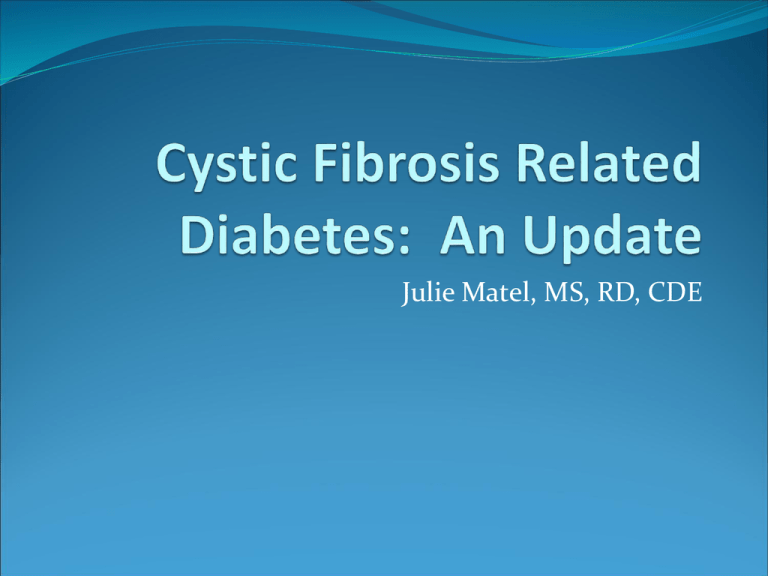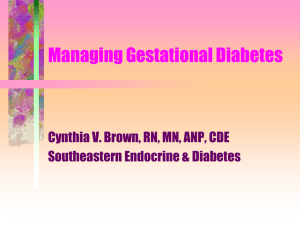
Julie Matel, MS, RD, CDE
Cystic Fibrosis Related Diabetes
Type 1: lack of insulin
Type 2: insulin resistance/
secretion
decreased insulin secretion
CFRD Is a Distinct Form of Diabetes
Type 1
Type 2
CFRD
Most common age of onset
<20
>40
22-24
Usual body habitus
Normal
Obese
Normal
Insulin Secretion
Absent
↓
↓
Insulin Sensitivity
↓
↓↓↓
↓
Autoimmune etiology
Yes
No
No
Ketoacidosis
Yes
Rare
Rare
Microvascular complications
Yes
Yes
Yes
Macrovascular complications
Yes
Yes
No
Moran A, et al. Diabetes Res Clin Pract. 1999.
Microvascular Complications in Subjects
with Diabetes > 10 Years Duration
98 patients with CFRD with FH, 39 patients >10 yrs duration
Complication
CFRD
T1D/T2D
Retinopathy
15%
60%
Nephropathy
16%
20-30%
Neuropathy
50%
50%
Gastropathy
Macrovascular
50%
0%
50%
~60%
Schwarzenberg, Moran et al. Diabetes Care. 2007
Clinical Signs and Symptoms of
Diabetes in CF
Excessive thirst or excessive urination
Failure to gain or maintain weight despite nutritional
intervention
Failure to grow
Delayed progression of puberty
Chronic decline in pulmonary function
Moran A, et al. Diabetes Res Clin Pract. 1999.
Decline in Pulmonary Functions and Nutritional
Status Precedes Development of Diabetes
“Prediabetic state may be deleterious because a greater
decline in pulmonary function and nutritional state
was found as early as 6 years before the diagnosis of
diabetes.”
Bismuth, E. et al J Pediatr 2008;152:540-5
CFRD has an impact on patient outcomes…
Reduced survival
In a study of 448 people with CF, less than 25% with
diabetes survived to age 30, whereas nearly 60% of
people without diabetes reached this age
Finkelstein et al J Pediatr 1988
Decreased Pulmonary Function
Cross sectional analysis of 7566 people enrolled in the
European Epidemiologic Registry of CF found lower
FEV1% in those with DM vs those without DM at all
ages (72% vs 52%)
Koch et al Pediatr Pulmonol 2001
Screening for CFRD
High Risk: Pre- and 2hr post-prandial glucose
Hospitalized
Oral or iv corticosteroids
Pregnancy
At least annual glucose screening for all patients
with CF >10 years of age (LPCH >6 years of age)
Hemoglobin A1c > 6.5 diagnostic for diabetes
Hemoglobin A1c < 6.5 does not rule out diabetes
or glucose impairment related to CF
Moran A, et al. Diabetes Res Clin Pract. 1999.
Oral Glucose Tolerance Test
Fasting, 30 minute, 1 hour, 2 hour blood draws after
glucose beverage
Most sensitive way to detect CFRD without fasting
hyperglycemia
Early Identification is important
High risk for progression to fasting hyperglycemia
High risk for excessive decline in pulmonary function
Moran A, et al. Diabetes Res Clin Pract. 1999.
Milla CE, et al. Am J Respir Crit Care Med. 2000.
Glucose Tolerance Categories in CF with
OGTT
Normal Glucose Impaired
Glucose
Tolerance
Tolerance
CFRD without
Fasting
Hyperglycemia
CFRD with
Fasting
Hyperglycemia
FBG:
FBG:
FBG:
FBG:
< 100 mg/dl <100 mg/dl <100 mg/dl >126 mg/dl
2 hour post 2 hour post
prandial:
prandial:
<140 mg/dl 141-199
mg/dl
2 hour post 2 hour post
prandial:
prandial:
>200 mg/dl >200 mg/dl
Glucose Tolerance Prevalence in
Patients with CF
100
23
36
Percent Prevalence
Within Age Group
80
30
57
60
38
27
38
40
34
20
20
15
6
0
27
3
5-9
11
15
16
10-19
20-29
30+
Age (years)
Normal glucose tolerance
Impaired glucose tolerance
CFRD without fasting hyperglycemia
CFRD with fasting hyperglycemia
Moran A, et al. J Pediatr. 1998.
Insulin or C-peptide
Insulin Secretion is Decreased in CF
Patients With and Without Diabetes
*
*
PS=pancreatic sufficient
DM=diabetes mellitus
Control
CF-PS CF-no DM CFRD
* P<0.001 vs control
Moran A, et al. J Pediatr. 1991.
Metabolic Consequences of Insulin
deficiency in CF
Malnourished or very sick CF patient are severely
protein catabolic.
Healthy, well-nourished CF patients have subtle
defects in protein and fat breakdown that may
compromise nutrition.
Increased protein and fat breakdown can be
prevented if high enough insulin levels are
achieved, providing rationale for insulin
treatment even in the face of relatively normal
blood glucose levels.
Moran et al: Diabetes 50:1336-1343,2001
Hardin et al: Pediatrics 101:433-437,1998
Insulin Therapy to Improve BMI in Cystic FibrosisRelated Diabetes Without Fasting Hyperglycemia
n= 81
People with CF and CFRD without fasting
hyperglycemia were treated with insulin vs.
Repaglinide or placebo
Insulin group showed improved BMI after one year of
therapy whereas the group treated with Repaglinide
did not
Moran A. et al. Diabetes Care. 2009.
Goals of Medical Nutrition Therapy
Achievement of optimal nutritional status
Provision of sufficient calories
Calorie restriction is never appropriate
Near-normalization of blood glucose
Management of hyperglycemia and hypoglycemia
Necessary for energy balance
Insulin is an anabolic hormone
Flexible meal planning approach to optimize
energy intake
Meal plan should be based on usual food intake and patterns
Key Dietary Considerations
No restrictions on calorie or total carbohydrate intake
Consistent carbohydrate diets may not be feasible
Consume high fat diet (35-40% of calories)
Best option is carbohydrate counting with short acting
pre-meal insulin to match carbohydrate intake
Allows adequate calorie intake/flexible schedule
Improved Outcomes with More
Aggressive Management
Minnesota data
Cystic Fibrosis-Related Diabetes: Current Trends in
Prevalence, Incidence, and Mortality
Over the past 15 years, > 50% decrease in mortality in
male and females with diabetes with absence of a sex
difference
Mortality remains significantly higher in CF patients
with diabetes compared to those without, but the gap
has narrowed
Moran A. et al. Diabetes Care. 2009.
What does more aggressive
management mean?
Routine screening with annual oral glucose tolerance
test (OGTT) for patients aged > 6 years
Careful inpatient glucose monitoring and use of
insulin as needed
Early institution of intensive insulin therapy has
become more routine in the last 5 years
Pre-meal insulin is prescribed for those with CFRD
without fasting hyperglycemia
LPCH/Stanford Protocol for
Diabetes Management
Annual OGTT for patients > 6 years
Endocrine consult for those with OGTT indicating
CFRD without fasting hyperglycemia or CFRD
Inpatient Screening for CFRD
Monitor fasting BG and 2 hour post meal for 48 hours
upon admission to the hospital
Summary
Early screening may help identify folks at risk for
developing glucose abnormalites
Early treatment of glucose abnormalities may improve
nutrition and pulmonary outcomes
New diabetes screening and treatment guidelines are
being developed by a CFF consensus committee so….
Stay Tuned!










